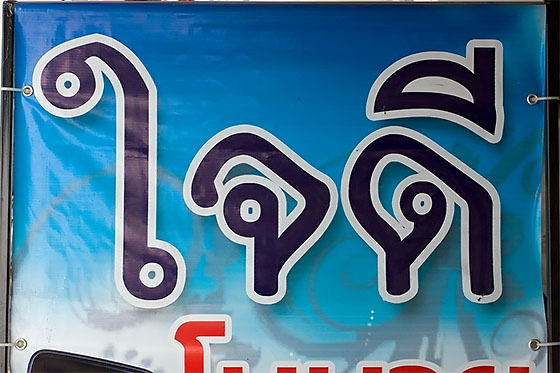Learn How To Read Thai - Tutorial 20
Remaining Consonants
In this tutorial I will wrap up the remaining consonants. Some of the consonants I have covered already are used very rarely and that is also the case for the ones that remain.
For anyone learning to read Thai I strongly suggest obtaining or making a wall chart (link opens pop-up image) and then annotating it with the information I have provided. This tutorial will enable you to finish the wall chart.
For each Thai consonant on your wall chart you should write down the initial and final sounds, the consonant class, and the usage. Displaying the wall chart in a prominent position near to where you study will help you to remember each consonant.
This is exactly what I did and I remember a time when I needed to look at my wall chart frequently. After a while I could remember the consonants and didn't need to refer to the wall chart.
ฎ
Name in Thai: ฎ ชฎา
Name in English: Dor Chadaa (crown)
Initial: d
Final: t
Class: Mid
Usage: Very rare
Writing practice: Download Worksheet
Comments: Seldom seen. The Thai consonant 'dor dek' performs exactly the same function and is the same consonant class. Therefore this consonant isn't necessary.
ฏ
Name in Thai: ฏ ปฏัก
Name in English: Dtor Bpa-dtuk (spear)
Initial: dt
Final: t
Class: Mid
Usage: Very rare
Writing practice: Download Worksheet
Comments: Seldom seen. This character is written very similarly to the one above except there is a little more detail in the squiggly stuff at the bottom. The Thai consonant 'dtor dtao' performs exactly the same function and is the same consonant class. Therefore this consonant isn't necessary.
ณ
Name in Thai: ณ เณร
Name in English: Nor Nane (novice monk)
Initial: n
Final: n
Class: Low
Usage: Fairly rare
Writing practice: Download Worksheet
Comments: This is another 'n' consonant but used a lot less than nor noo (Tutorial 8). It does come up but not that often. It is written similarly to chor cher (Tutorial 19) so be careful.
Used alone it acts as a preposition and can mean: in, on, at, of, as of.
Events in Thailand are normally advertised using large posters. If you see a poster advertising an event and want to know where it is being held, the location will normally be written after nor nane.
Here's an example:

Hat Yai Motor Show is written in English, so that isn't a problem. It runs from the 1st to 5th of April, which is fairly easy to translate. If you want to know where it is being held, scan for nor nane. Can you see it just below the figure 1 in the date?
Following nor nane it says 'soon bpra-chuum naa-naa-chart mor or haat yai
The word 'bpra-chuum' means 'meeting', 'soon' means 'centre' and 'naa-naa-chart' means 'international'. The best translation is probably 'international conference centre'. Locally, the Prince of Songkla University is known as 'Mor Or'. The conference centre is part of the university/hospital complex.
ฬ
Name in Thai: ฬ จุฬา
Name in English: Lor Juulaa (kite)
Initial: l
Final: n
Class: Low
Usage: Very rare
Writing practice: Download Worksheet
Comments: Seldom seen. I only know a few words that use this consonant. The Thai word for sport (gee-laa), the word for a watch or clock (naa-li-gaa), and the final 'l' in the Thai word for 'whale'. The other 'l' consonant lor ling (Tutorial 8) is much more common.
I am not aware of any Thai words that begin with this consonant.

soon som naa-li-gaa - Watch repair centre

sa-naam gee-laa - Sports stadium
วาฬ - waan (whale)
I find this very strange. Thai has 'borrowed' lots of words from English and whenever a borrowed word contains an 'l' it is always transliterated using the Thai consonant 'lor ling'. All words, that is, apart from this one, which uses 'lor juulaa'. I don't know why.
Regardless of whether 'lor ling' or 'lor juulaa' is used, both consonants make an 'n' sound in Thai when used as final consonants.
Another small point to make is that the full name in Thai is 'bplaa waan'. This translates to fish whale but whales are not fish, of course.
ปลาวาฬ - bplaa waan (fish whale)
Summary
I have now covered all the Thai consonants. We started off with 44 but quickly saw that two are now obsolete. The consonants in this tutorial, as well as several others in previous tutorials, are used only rarely.
My reason for including an indication of usage with each consonant was to let you know how often you might expect to see each one.
If you just concentrate at first on those characters that are very common, or fairly common, it shouldn't take you long to memorise them as they are only a fairly small subset of the original 44.
Then, by memorising a few simple vowels and rules you will find that you can read lots of things in Thailand. It's really not that difficult. If I can do it, anyone can.
Questions And Feedback
If you have any comments, questions or suggestions, feel free to contact me. Your feedback will help me to improve these pages.
Recommended Books
Amazon UK
Amazon UK
Amazon US
Amazon US

